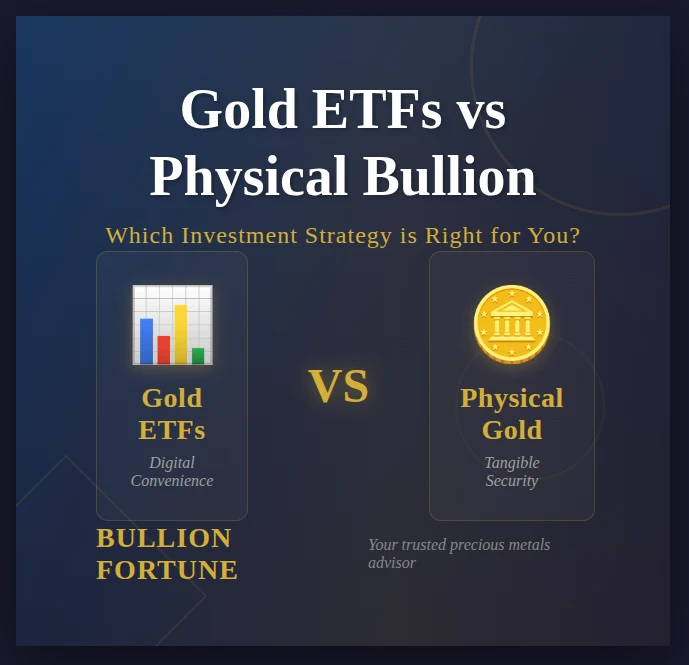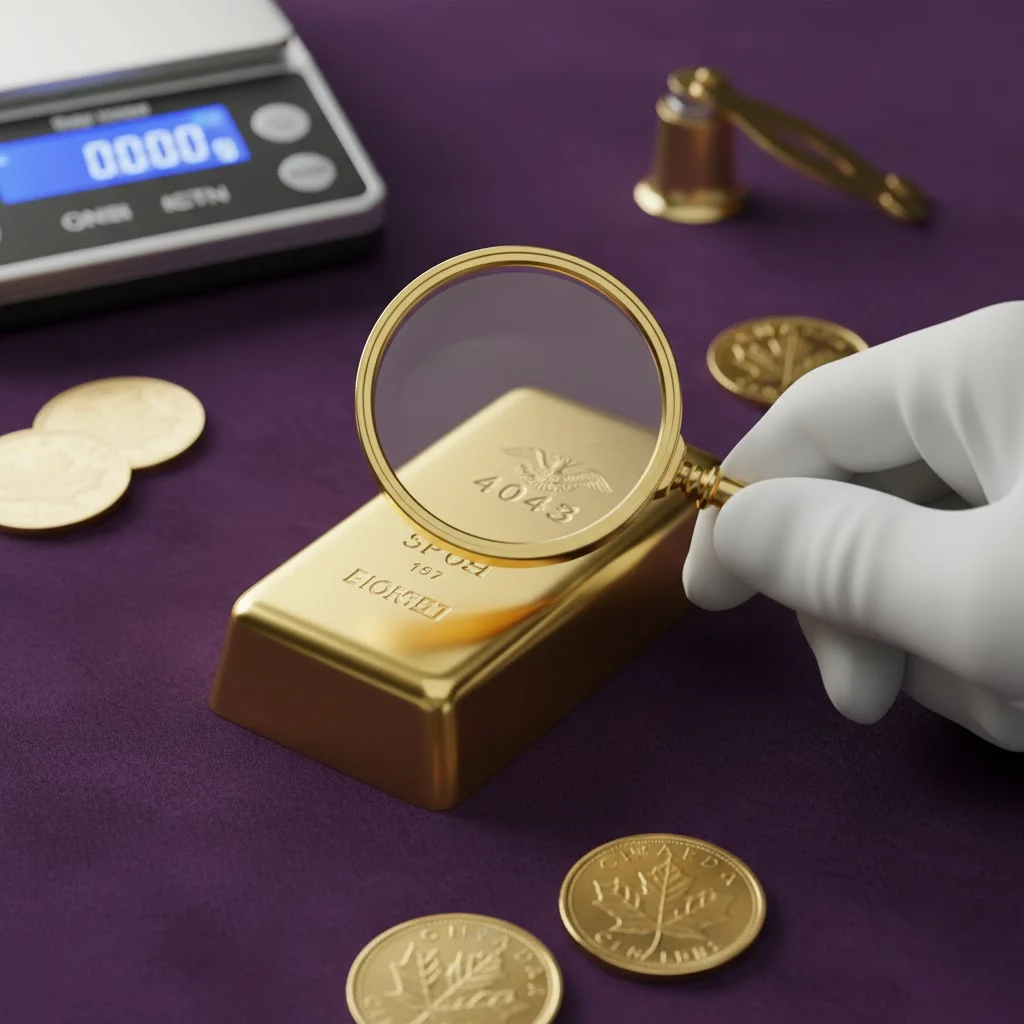When I first started looking into gold investment a few years back, I thought buying gold meant walking into a dealer’s shop and walking out with shiny bars in a briefcase. Turns out, there’s a whole other way to invest in gold that doesn’t involve any physical metal at all—Gold ETFs. Both options have their place, but they’re completely different animals.
Let me break down what I’ve learned about both approaches, because choosing between them isn’t as straightforward as you might think.
What Exactly Are Gold ETFs?
Gold ETFs (Exchange-Traded Funds) are basically investment funds that track the price of gold. When you buy shares in a gold ETF, you’re buying a piece of a fund that holds either physical gold in vaults or gold derivatives. The most popular one in the U.S. is SPDR Gold Shares (GLD), but there are others like iShares Gold Trust (IAU).
Think of it like this: instead of buying an actual gold bar, you’re buying a receipt that says you own a portion of gold that someone else is storing for you. Your shares trade on the stock market just like Apple or Tesla stock. The price goes up and down with the spot price of gold, minus some fees.
The appeal is obvious—you get exposure to gold’s price movements without dealing with storage, insurance, or security. You can buy and sell with a few clicks during market hours, and you don’t need thousands of dollars to get started. Want to invest $500 in gold? No problem with ETFs. Try doing that with physical bars.

The Case for Physical Bullion
Now, physical gold is the real deal. We’re talking gold coins, bars, and rounds that you can hold in your hand. American Gold Eagles, Canadian Maple Leafs, Credit Suisse bars—actual metal that’s been refined and stamped.
There’s something undeniably satisfying about owning physical gold. When you hold a one-ounce coin in your hand, you’re holding something that’s been valuable for thousands of years. No company can go bankrupt and take your gold with it. No government can freeze your account. No computer glitch can make it disappear.
Physical gold is the ultimate insurance policy. If the financial system goes sideways, your gold is still gold. It doesn’t rely on any third party to maintain its value. This is why serious preppers and financial doomsday believers almost always choose physical metal over ETFs.
The Liquidity Question
Here’s where ETFs really shine. Need to sell some gold because an unexpected expense came up? With an ETF, you log into your brokerage account, click “sell,” and boom—you’ve got cash in your account within two business days. Easy as ordering a pizza.
Physical gold? Not quite as smooth. You need to find a buyer, which usually means going back to a dealer or using an online marketplace. Most reputable dealers will buy back what they sold you, but they’re going to offer you less than spot price. That’s called the bid-ask spread, and it can eat into your returns. Then there’s shipping if you’re selling online, insurance for that shipment, and waiting for payment to clear.
Sure, you could sell to a local pawn shop or gold buyer, but those guys are notorious for lowball offers. I’ve heard stories of people getting offered 60-70% of spot price from these places. That’s not a sale—that’s robbery with a handshake.
That said, physical gold has one liquidity advantage nobody talks about: it’s universally recognized. A Gold Eagle coin is accepted anywhere in the world. Your ETF shares? They only work if stock markets are functioning and your brokerage is operational.
The Real Cost of Ownership
Let’s talk money, because both options come with costs that add up over time.
Gold ETFs charge an annual expense ratio, usually around 0.4% for the big ones. That means if you have $10,000 in a gold ETF, you’re paying about $40 per year for the privilege. Doesn’t sound like much, but over 10 years at 0.4% annually, you’re looking at roughly $400 on that same $10,000. The fund automatically deducts this from your holdings, so you don’t write a check—but you’re paying it nonetheless.
Physical gold has different costs. First, there’s the premium over spot price. When gold is trading at $2,000 per ounce, you might pay $2,050 or more depending on what you’re buying. Coins typically have higher premiums than bars. Those premiums can range from 2% to 10% or even higher for rare or collectible pieces.
Then there’s storage. Keep it at home, and you should probably get a good safe—that’s anywhere from $500 to several thousand dollars. Keep it in a bank safe deposit box, and you’re paying $50-$300 per year depending on size and location. Use a private vault service, and costs vary widely but expect to pay 0.5% to 1% of your gold’s value annually.
Insurance is another factor if you’re storing at home. Your homeowner’s or renter’s insurance might cover some precious metals, but probably not much. Special riders for precious metals can run you another 1-2% per year of the insured value.
Do the math, and physical gold’s ongoing costs can actually exceed ETF expense ratios, especially for smaller holdings. But for larger amounts, the percentage costs of physical storage often become more favorable.
Tax Treatment—This Gets Interesting
Both physical gold and gold ETFs are classified as “collectibles” by the IRS, which means they’re taxed at a maximum capital gains rate of 28% if you hold them for more than a year. That’s higher than the typical 15-20% long-term capital gains rate for stocks.
With ETFs, tax reporting is straightforward. Your brokerage sends you a 1099-B showing your gains or losses. Simple.
Physical gold can be trickier. If you sell more than 25 one-ounce Maple Leafs, or more than 1,000 ounces of silver, dealers are required to report the transaction to the IRS using Form 1099-B. Below those thresholds, there’s no automatic reporting—but you’re still legally required to report the gains yourself. Some people, let’s say, don’t always do this. I’m not recommending tax evasion, but it’s worth noting that physical gold offers more privacy in smaller transactions.
The Counterparty Risk Factor
This is where physical gold advocates get passionate. Counterparty risk means you’re dependent on another party to make good on their obligations.
With ETFs, you’re trusting that:
- The fund actually holds the gold it claims to hold
- The fund’s custodian (usually a big bank) doesn’t go under
- The brokerage holding your shares stays solvent
- The legal structure of the ETF remains intact
- Markets remain open and functional
Most of the time, this is fine. Reputable ETFs like GLD are audited and transparent about their holdings. But in a major financial crisis—the kind that makes people buy gold in the first place—these dependencies become vulnerabilities.
Physical gold has zero counterparty risk. Once you own it and it’s in your possession, it’s yours. Period. No bank failure, no brokerage bankruptcy, no fund liquidation can touch it.
The flip side? Physical gold has theft risk and loss risk. If someone breaks into your house or your boat sinks (yes, “lost it in a boating accident” is an inside joke in the precious metals community), your gold is gone. With an ETF, those risks don’t exist.
Flexibility and Accessibility
ETFs win hands down on convenience. You can buy them in any brokerage account, including retirement accounts like IRAs. You can set up automatic investments. You can sell instantly during market hours. You can buy fractional amounts—want $37 worth of gold exposure? Go for it.
Physical gold requires more commitment. Minimum purchases are usually at least one ounce for coins ($2,000+) or one gram for bars ($60+). You need to think about storage before you buy. You need to plan your purchases around shipping times. And if you want gold in an IRA, you need a special self-directed IRA with an approved custodian—whole different ballgame.
But physical gold offers something ETFs can’t: true portfolio diversification. Your physical gold isn’t correlated with the financial system because it exists outside that system. It’s a genuine alternative asset. ETFs, on the other hand, are still paper assets traded in the same markets as everything else.
When ETFs Make More Sense
Gold ETFs are probably the better choice if you:
- Want to actively trade gold based on price movements
- Are investing smaller amounts (under $5,000)
- Need liquidity and can’t wait days to sell
- Want gold exposure in a retirement account without the hassle
- Aren’t worried about worst-case financial scenarios
- Prefer simplicity and don’t want to deal with physical storage
- Are comfortable with counterparty risk in exchange for convenience
When Physical Bullion Makes More Sense
Physical gold is likely the better option if you:
- View gold primarily as insurance against systemic financial risk
- Are investing larger amounts (over $10,000) where economies of scale work in your favor
- Value privacy and want to minimize paper trails
- Want assets outside the financial system that you directly control
- Don’t need immediate liquidity
- Are willing to deal with storage and security concerns
- Have a long-term buy-and-hold strategy

My Take: Why Not Both?
Here’s what makes sense to me after diving deep into this: for most people, a combination approach is probably best.
Use ETFs for the core of your gold allocation—maybe 60-70%. They’re efficient, liquid, and easy to rebalance. If gold spikes and becomes 15% of your portfolio when you wanted 10%, you can trim it back in five minutes.
But keep some physical gold too—maybe 30-40% of your gold allocation. Think of this as your “emergency gold.” It’s there for scenarios where financial markets aren’t functioning normally. It’s your insurance policy on the insurance policy.
If you’re investing less than $3,000 in gold total, just stick with ETFs. The premiums and storage costs of physical gold will eat you alive at that scale. Once you get above $5,000 or $10,000, start adding some physical metal to the mix.
The Bottom Line
Gold ETFs and physical bullion are both legitimate ways to invest in gold, but they serve different purposes. ETFs are financial instruments that give you convenient exposure to gold’s price. Physical bullion is tangible wealth that exists independent of the financial system.
Neither is universally “better”—it depends entirely on your goals, your risk tolerance, and what you’re trying to accomplish. If you’re speculating on gold’s price movements or want a small allocation to diversify your portfolio, ETFs are fantastic. If you’re protecting against catastrophic scenarios or want the psychological security of holding real metal, nothing beats physical bullion.
The good news? You don’t have to choose just one. Understanding the trade-offs lets you build a gold strategy that uses each type of investment for what it does best.
Whatever you decide, just make sure you’re buying gold for the right reasons. It’s not a get-rich-quick scheme—it’s wealth preservation. Done right, it’s one of the smartest financial decisions you can make.







Leave a comment